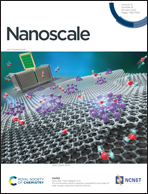Strain-induced ordered Ge(Si) hut wires on patterned Si (001) substrates
Abstract
Ge/Si nanowires are predicted to be a promising platform for spin and even topological qubits. While for large-scale integration of these devices, nanowires with fully controlled positions and arrangements are a prerequisite. Here, we have reported ordered Ge hut wires by multilayer heteroepitaxy on patterned Si (001) substrates. Self-assembled GeSi hut wire arrays are orderly grown inside patterned trenches with post growth surface flatness. Such embedded GeSi wires induce tensile strain on the Si surface, which results in preferential nucleation of Ge nanostructures. Ordered Ge nano-dashes, disconnected wires and continuous wires are obtained correspondingly by tuning the growth conditions. These site-controlled Ge nanowires on a flattened surface lead to the ease of fabrication and large-scale integration of nanowire quantum devices.

- This article is part of the themed collection: Nanoscale quantum technologies


 Please wait while we load your content...
Please wait while we load your content...